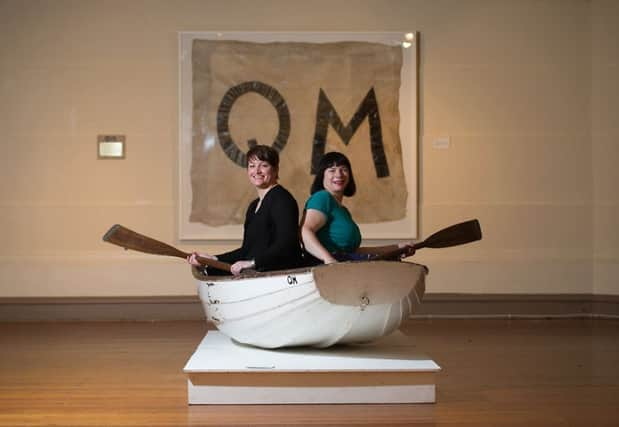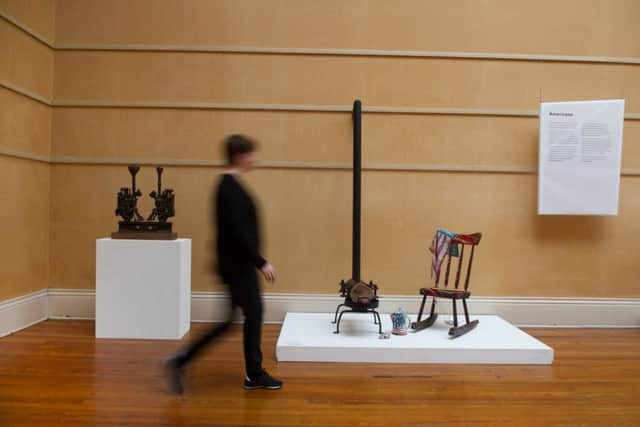Art review: The Why?Sman, Paisley Museum


The Why?Sman - Paisley Museum
* * * *
Demobbed, like Robert Burns (and the Douanier Rousseau), he became a customs officer and he didn’t really start to make art on a substantial scale until shortly before he retired in 1979. Artistically, therefore, he was a contemporary of Steven Campbell rather than of his actual contemporaries like Alan Davie, for instance, whose careers had taken off 30 years earlier. Perhaps that’s why there was always something youthful about him, especially in the irreverent humour that marked his art from the start. A Machine for Applauding Paintings with Critic’s Thumb Attachment and Mona Lisa, for instance, was made in 1976. It is a collection of around 20 hands on flexible steel arms, all attached to a crank handle. Notionally at least, when the handle is rotated the hands all clap to applaud the Mona Lisa on the wall behind.


There are other early pieces in the exhibition in a similar comic mode and I remember a conversation with Wyllie just at this time in which he asked if I thought he should continue with this kind of comic work or become more serious. It was a rather Scottish debate he was having with himself, for it had echoes back to Wilkie and even Burns, who were assailed by similar doubts. In the event all three, Burns, Wilkie and Wyllie himself, resolved the dilemma by managing to be both comic and serious at the same time. With Wilkie and Burns, it was a vital part of what gave their art such enduring appeal. Though his art was very different, Wyllie, too, became a genuinely popular figure. Indeed, he really became Scotland’s National Jester.
Advertisement
Hide AdLike a jester, too, performance increasingly became part of what he did and, just as a jester should, he took to singing and playing his ukelele. There are some wonderful pieces of film in the exhibition, notably extracts from Murray Grigor’s film The Why?sman, which show him performing his made-up comic songs as part of the performances which accompanied his major art installations. It was typical of his overflowing creativity, too, that a performance he developed at an exhibition at the Third Eye Centre in 1982 evolved, in collaboration with Russell Hunter, into A Day Down a Goldmine, a proper, two-handed play and a satire on a society in which all values can be reduced to money. It went on tour with Wyllie himself, playing opposite Bill Paterson.
In medieval times, the jester also had the privilege of speaking truth to power, and Wyllie took that on too, confirmed in his conviction that his art had to have a social purpose by getting to know Josef Beuys through Richard Demarco. He was also befriended by Scots-American kinetic sculptor George Rickey, and worked with him in the States. While both these international figures were an inspiration to him, his most ambitious and most effective undertakings were very much his own, inspired by his anger at the brutal dismantling of Scotland’s heavy industries by the Conservative government in the 1980s. The first of these, recorded here in a film, in drawings and by other related objects, was the Straw Locomotive. Made in 1987, it was a full-sized effigy of a steam engine, like those once made in Glasgow, but straw, not steel. It was slung from the Finnieston Crane, the last great crane on the Clyde. Taken down, it was then ceremonially burnt as though in a Viking funeral, making a fiery obsequy for Glasgow’s heavy industries. After the conflagration, a large question mark was revealed at the centre of the locomotive’s wire frame.
The other great project was his Paper Boat, a full-size, seagoing boat, but made in the shape of an origami paper boat. It is represented here by film, drawings, documents and other, usually ironic memorabilia. Called QM for Question Mark, the Paper Boat also revealed a question mark at its centre when its superstructure was opened. Wyllie sailed it up the Thames to the City of London and to New York. Like the straw of the Locomotive, fragile paper replaces durable steel, but though it is so fragile, in books paper can also have great power and Wyllie took with him in his Paper Boat, not just his question mark, but a copy of Adam Smith’s Theory of Moral Sentiment. In it, Smith answered the questions left unanswered by pure economics, questions that were beginning to be highly topical with the rise, ironically often in Smith’s name, of neo-liberalism, and the idea that you can put a price on everything and anything. Thus the Paper Boat presented the same argument as A Day Down a Goldmine, but to a huge audience, for its arrival at its various destinations, as they are recorded here in film, became a great public spectacle.
Wyllie was also deeply concerned about the escalating ecological crisis and it became a constant theme in his later work. Partly inspired by Beuys and Patrick Geddes, he felt we need equilibrium in our relationship with nature, or in Geddes’s word, synergy: the confluence, not divergence, of energy and ideas. Wyllie represented this in various ways, most notably in the form of a spire, a tall pole with a rock at its base set in a gimbal so that it is free to swing between earth and sky, but finds its equilibrium in doing so. There are several fascinating examples in the show. In Eco-Bucket,for instance, a small spire swings on the raised handle of a steel bucket. On the same theme, and equally typical in its humour, was his bicycle imagery. William Blake was one of his heroes so he gave Blake a bike, Blake’s Bike, a saddle with wings. “In the beginning you can’t ride a bike, then in an instant, you irrevocably lose your imbalance. This is the Synenergezetic moment! Now you cannot unride the bike. You are in equilibrium.” Comic, paradoxical, but true, and with a typical neologism, there speaks the Why?sman.
Until 13 September